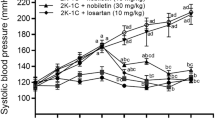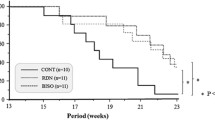Abstract
Gene therapy has been applied to reduce blood pressure in rats. However, little is known about the effects of gene therapy on both blood pressure and left ventricular (LV) remodeling. This study was designed to compare the antihypertensive effect of ß1 adrenergic receptor antisense oligodeoxynucleotides (ß1- AS-ODN) by delivery with the different charge ratios cationic liposomes DOTAP/DOPE and its impact on the LV remodeling in rats with 2-Kidney, 1-Clip (2K1C) Hypertension. Five charge ratios of liposome/ODN were tested in 2K1C rats. There was hypertension, cardiac dysfunction, LV hypertrophy and LV collagen deposition in 2K1C rats. On the basis of the magnitude and duration of hypotension, 2.0 was determined to be the optimal charge ratio, which decreased blood pressure by up to 39 mm Hg for 27 days. ß1-AS-ODN preserved cardiac function and inhibited LV mass and LV interstitial collagen deposition. In conclusion, cationic liposomes DOTAP/DOPE improve the antihypertensive effects of ß1-AS-ODN in renovascular hypertension and 2.0 were determined to be the optimal charge ratio. This study demonstrated that cardiac ß1-AR played a key role in LV remodeling and ß1-AS-ODN ameliorates cardiac dysfunction and LV remodeling.
Similar content being viewed by others
References
Johansson M., Elam M., Rundqvist B., Eisenhofer G., Herlitz H., Friberg P. (1999) Increased sympathetic nerve activity in renovascular hypertension. Circulation 99:2537–2542
Grisk O., Rettig R. (2004) Interactions between the sympathetic nervous system and the kidneys in arterial hypertension. Cardiovasc. Res. 61:238–246
Jacob F., LaBine B.G., Ariza P., Katz S.A., Osborn J.W. (2005) Renal denervation causes chronic hypotension in rats: role of beta1-adrenoceptor activity.Clin. Exp. Pharmacol. Physiol. 32:255–262
Zhang Y.C., Bui J.D., Shen L., Phillips M.I. (2000) Antisense inhibition of β1-adrenergic receptor mRNA in a single dose produces a profound and prolonged reduction in high blood pressure in spontaneously hypertensive rats. Circulation 101:682–688
Clare Zhang Y., Kimura B., Shen L., Phillips M.I. (2000) New beta-blocker: prolonged reduction in high blood pressure with beta1 antisense oligodeoxynucleotides. Hypertension 35:219–224
Weil J., Zolk O., Griepentrog J., Wenzel U., Zimmermann W.H., Eschenhagen T. (2006) Alterations of the preproenkephalin system in cardiac hypertrophy and its role in atrioventricular conduction.Cardiovasc. Res.69:412–422
Chen H., Zhang Y.C., Li D., Phillips M.I., Mehta P., Shi M., Mehta J.L. (2000) Protection against myocardial dysfunction induced by global ischemia-reperfusion by antisense-oligodeoxy-nucleotides directed at beta (1)-adrenoceptor mRNA. J. Pharmacol. Exp. Ther. 294:722–727
Mulder P., Boujedaini H., Richard V., Henry J.P., Renet S., Munter K., Thuillez C. (2002) Long-term survival and hemodynamics after endothelina receptor antagonism and angiotensin-converting enzyme inhibition in rats with chronic heart failure: monotherapy versus combination therapy. Circulation 106:1159–1164
Liang Y.H., Wang J.M., Zhou Y., Jiang X.J., Jiang H., Huang C.X. (2004) Additive effects of combined valsartan and spironolactone on cardiac aldosterone escape in spontaneously hypertensive rats. Life Sci. 75:1871–1878
Varagic J., Frohlich E.D., Diez J., Susic D., Ahn J., Gonzalez A., Lopez B. (2006) Myocardial fibrosis, impaired coronary hemodynamics, and biventricular dysfunction in salt-loaded SHR. Am. J. Physiol. Heart Circ. Physio. 290:H1503–1509
DiBona G.F. (2004) The sympathetic nervous system and hypertension: recent developments. Hypertension 43:147–150
Vitela M., Herrera-Rosales M., Haywood J.R., Mifflin S.W. (2005) Baroreflex regulation of renal sympathetic nerve activity and heart rate in renal wrap hypertensive rats. Am. J. Physiol. Regul. Integr. Comp. Physiol. 288:R856–862
Yang J.P., Huang L. (1998) Time-dependent maturation of cationic liposome-DNA complex for serum resistance. Gene Ther. 5:380–387
Choi W.J., Kim J.K., Choi S.H., Park J.S., Ahn W.S., Kim C.K. (2004) Low toxicity of cationic lipid-based emulsion for gene transfer. Biomaterials 25:5893–5903
Templeton N.S., Lasic D.D., Frederik P.M., Strey H.H., Roberts D.D., Pavlakis G.N. (1997) Improved DNA: liposome complexes for increased systemic delivery and gene expression. Nat. Biotechnol. 15:647–652
Raizada M.K., Der Sarkissian S. (2006) Potential of gene therapy strategy for the treatment of hypertension. Hypertension 47:6–9
Vinch C.S., Aurigemma G.P., Simon H.U., Hill J.C., Tighe D.A., Meyer T.E. (2005) Analysis of left ventricular systolic function using midwall mechanics in patients > 60 years of age with hypertensive heart disease and heart failure. Am J Cardiol 96:1299–1303
Edvardsen T., Rosen B.D., Pan L., Jerosch–Herold M., Lai S., Hundley W.G., Sinha S., Kronmal R.A., luemke D.A., Lima J.A. (2006) Regional diastolic dysfunction in individuals with left ventricular hypertrophy measured by tagged magnetic resonance imaging–the Multi-Ethnic Study of Atherosclerosis (MESA). Am. Heart. J. 151:109–114
Burns J., Mary D.A., Mackintosh A.F., Ball S.G., Greenwood J.P. (2004) Arterial pressure lowering effect of chronic atenolol therapy in hypertension and vasoconstrictor sympathetic drive. Hypertension 44:454–458
Greenwood J.P., Scott E.M., Stoker J.B., Mary D.A. (2001) Hypertensive left ventricular hypertrophy: relation to peripheral sympathetic drive. J. Am. Coll. Cardiol. 38:1711–1717
Schlaich M.P., Kaye D.M., Lambert E., Sommerville M., Socratous F., Esler M.D. (2003) Relation between cardiac sympathetic activity and hypertensive left ventricular hypertrophy. Circulation 108:560–565
Author information
Authors and Affiliations
Corresponding authors
Rights and permissions
About this article
Cite this article
Liang, Y., Lin, S., Zhou, Y. et al. Beta-1 adrenergic receptor antisense-oligodeoxynucleotides ameliorates left ventricular remodeling in 2-Kidney, 1-Clip rats. J Biomed Sci 14, 155–164 (2007). https://doi.org/10.1007/s11373-006-9128-0
Received:
Accepted:
Published:
Issue Date:
DOI: https://doi.org/10.1007/s11373-006-9128-0




